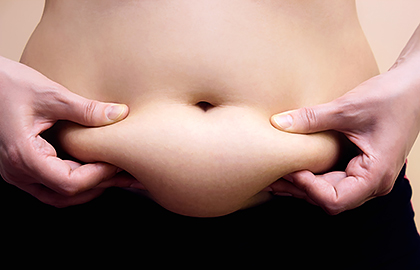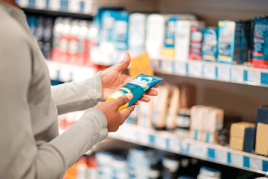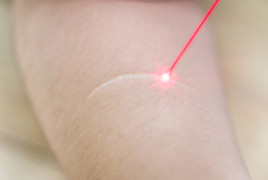Non-invasive fat removal: What can you expect?

Non-invasive fat removal can be used on just about any area of the body. The belly, flanks (love handles), thighs, chin, neck, back, upper arms, and knees are all treatable.
What exactly is non-invasive fat removal?
When you get non-invasive fat removal, a dermatologist uses either a handheld device or injections to destroy fat cells.
The U.S. Food and Drug Administration (FDA) has approved several handheld devices for this purpose. All devices are placed on or just above the skin. They work by sending cold, heat, or sound waves directly into the fat cells. Without injuring the skin, nerves, and other parts of the body, the devices can destroy fat cells.
The injections contain an acid similar to bile acid, the substance that allows our bodies to digest fat. Like bile acid, the acid in these injections dissolves fat cells. The FDA has approved these injections to treat a double chin.
Because these treatments kill or dissolve the fat cells, the results are permanent.
How can the results be permanent?
We are born with a certain number of fat cells. No matter how much weight we gain or lose, we still have the same number of fat cells. We look heavier when we gain weight because the fat cells expand. When we lose weight, our fat cells shrink.
Because non-invasive fat removal kills some fat cells, the targeted cells are gone forever. You’ll still have some fat cells in the treated area though. If you gain weight, these cells will expand, but you’ll see less fat in the treated area.
How long does it take to see results?
With non-invasive fat removal, the results appear gradually.
If you are treated with a device, you may notice some changes as early as 3 weeks. Most people see the full effect between 3 and 6 months after the last treatment.
You’ll usually see the full effect from the injections used to treat excess chin fat about 3 to 4 months after the last treatment. Some people see the full effects earlier.
Are the results similar to those seen with liposuction?
Liposuction delivers more-dramatic results. With non-invasive fat removal, the results are subtle. Your pants will feel a little loser or your belly a little flatter.
What is the recovery time for non-invasive fat removal?
Most people find that they can return to their everyday activities immediately after treatment. You may have some swelling, bruising, or discomfort afterwards, but this usually doesn’t cause downtime.
After getting the injections to treat excess chin fat, some people will be extremely swollen for as long as 2 weeks. Still, they can return to their normal activities.
How long does non-invasive fat removal take?
While there is usually no downtime, most people need to schedule time for office visits. Non-invasive fat removal generally requires more than one treatment session, and each session tends to last between 30 and 90 minutes. Some sessions take longer.
After the first treatment, your dermatologist will re-evaluate you in a few weeks to a month. The following chart shows how many treatment sessions a person usually needs.
| Method | Treatments required |
|---|---|
| Cryolipolysis: Device uses cold to freeze the fat, which destroys the fat. | Usually 2 treatment sessions |
| Ultrasound therapy: Device uses sound waves, which causes the fat to dissolve over time. | Between 1 and 3 treatments, depending on the device used |
| Radiofrequency: Device uses heat to destroy the fat. | Between 4 and 10 treatments |
| Injections: Used to dissolve excess chin fat. | Usually 2 treatment sessions, spaced 6 to 8 weeks apart |
What are the possible side effects?
After treatment, most people have some swelling, bruising, or discomfort. These are temporary. After getting the injections to dissolve excess chin fat, the skin on the chin may feel firm or lumpy. This, too, will fade.
It’s also possible that you’ll feel burning or stinging in the treated area. This may feel like the pins-and-needles sensation that you get when your leg or arm falls asleep. This, too, is temporary.
In rare cases, freezing the fat can cause long-term pain or increase the amount of fat in the treated area. You can reduce this risk by getting non-invasive fat removal from a dermatologist. These doctors understand the skin and what lies beneath. A dermatologist can also tell you if you are a good candidate for this treatment.
Who is a good candidate for non-invasive fat removal?
Good candidates for non-invasive fat removal have a small bulge of fat that remains despite diet and exercise and their weight falls within the normal range for their height.
If you think you may be a good candidate, you should see a board-certified dermatologist. You’ll want to meet with a dermatologist who has training in non-invasive fat removal and frequently treats patients with it. This doctor has the experience needed to tell you whether this treatment can successfully treat your concern.
Your dermatologist may also recommend another procedure to give you the results you seek. For example, if you also have loose skin, your dermatologist may recommend treating this first. That way, you’ll get better results from non-invasive fat removal.
You can find a dermatologist with training in non-invasive fat removal by going to Find a dermatologist. You’ll want to choose the specialty of Cosmetic Dermatology. When you call the office, ask if the dermatologist offers non-invasive fat removal.
Related AAD resources
Image
Getty Images
References
American Academy of Dermatology, “New non-invasive fat removal technologies offer alternative to liposuction for removing stubborn fat.” News release issued February 2012.
Margosian E and D’Arrigo T. “Body contouring carves out its niche.” Dermatol World. 2016;26(6):30-6.
 Think sun protection during Skin Cancer Awareness Month
Think sun protection during Skin Cancer Awareness Month
 How to care for your skin if you have lupus
How to care for your skin if you have lupus
 Practice Safe Sun
Practice Safe Sun
 Sunscreen FAQs
Sunscreen FAQs
 Fade dark spots
Fade dark spots
 Hidradenitis suppurativa
Hidradenitis suppurativa
 Laser hair removal
Laser hair removal
 Scar treatment
Scar treatment
 Botox
Botox
 Kids' camp - Camp Discovery
Kids' camp - Camp Discovery
 Dermatologist-approved lesson plans, activities you can use
Dermatologist-approved lesson plans, activities you can use
 Find a Dermatologist
Find a Dermatologist
 Why choose a board-certified dermatologist?
Why choose a board-certified dermatologist?